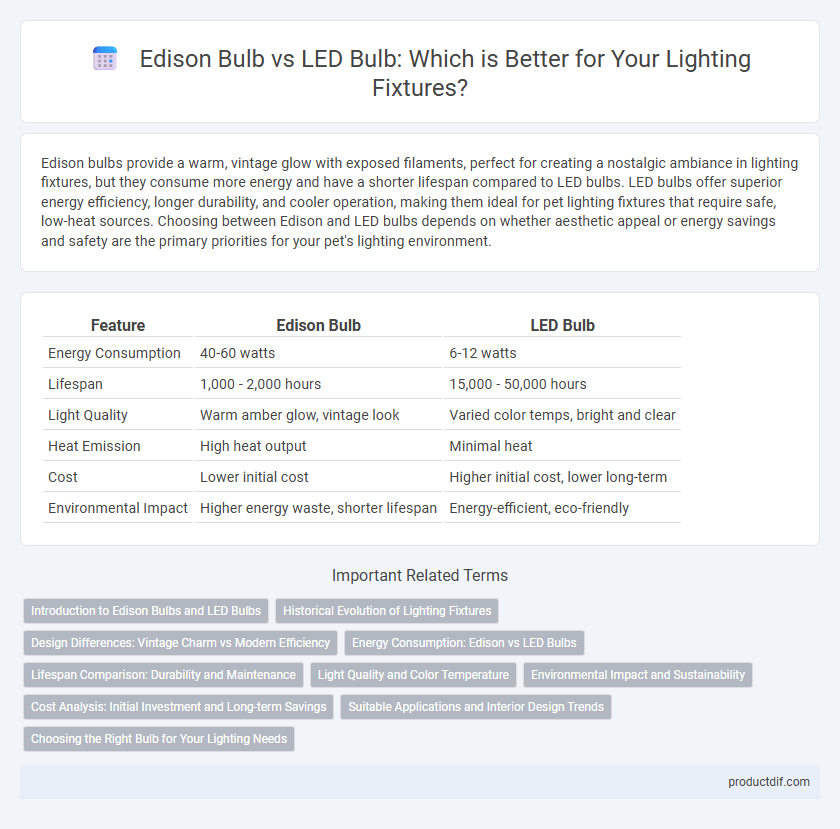Edison bulbs provide a warm, vintage glow with exposed filaments, perfect for creating a nostalgic ambiance in lighting fixtures, but they consume more energy and have a shorter lifespan compared to LED bulbs. LED bulbs offer superior energy efficiency, longer durability, and cooler operation, making them ideal for pet lighting fixtures that require safe, low-heat sources. Choosing between Edison and LED bulbs depends on whether aesthetic appeal or energy savings and safety are the primary priorities for your pet's lighting environment.
Table of Comparison
| Feature | Edison Bulb | LED Bulb |
|---|---|---|
| Energy Consumption | 40-60 watts | 6-12 watts |
| Lifespan | 1,000 - 2,000 hours | 15,000 - 50,000 hours |
| Light Quality | Warm amber glow, vintage look | Varied color temps, bright and clear |
| Heat Emission | High heat output | Minimal heat |
| Cost | Lower initial cost | Higher initial cost, lower long-term |
| Environmental Impact | Higher energy waste, shorter lifespan | Energy-efficient, eco-friendly |
Introduction to Edison Bulbs and LED Bulbs
Edison bulbs, characterized by their vintage filament design and warm amber glow, are popular for creating nostalgic and ambient lighting in various settings. LED bulbs, known for their energy efficiency and long lifespan, provide versatile lighting options with adjustable color temperatures and brightness levels. Both lighting fixtures serve distinct aesthetic and functional purposes, with Edison bulbs favoring style and LED bulbs emphasizing performance and sustainability.
Historical Evolution of Lighting Fixtures
Edison bulbs, invented by Thomas Edison in 1879, marked the beginning of practical electric lighting with their warm, incandescent glow produced by a carbon filament. LED bulbs, emerging in the 1960s and rapidly improving with advancements in semiconductor technology, offer energy-efficient, long-lasting alternatives with customizable color temperatures. The evolution from Edison's incandescent bulbs to LED technology represents a significant shift in lighting fixtures toward sustainability and enhanced functionality.
Design Differences: Vintage Charm vs Modern Efficiency
Edison bulbs feature exposed filaments and warm amber hues, embodying a vintage charm ideal for decorative and ambient lighting in rustic or industrial-style spaces. LED bulbs offer sleek, minimalist designs with compact forms and customizable color temperatures, prioritizing modern efficiency and longevity. The choice between Edison and LED bulbs hinges on whether the lighting fixture emphasizes nostalgic aesthetics or energy-saving performance.
Energy Consumption: Edison vs LED Bulbs
Edison bulbs typically consume 40 to 60 watts per bulb, whereas LED bulbs use only 6 to 10 watts for equivalent brightness, resulting in significantly lower energy consumption. LED technology converts most energy into light rather than heat, enhancing energy efficiency compared to the incandescent filament of Edison bulbs. Switching to LED bulbs can reduce electricity usage by up to 80% without sacrificing luminous output.
Lifespan Comparison: Durability and Maintenance
Edison bulbs typically have a lifespan of around 1,000 to 2,000 hours, making them less durable and requiring more frequent replacements compared to LED bulbs, which can last between 25,000 and 50,000 hours. The longer lifespan of LED bulbs reduces maintenance frequency and costs, contributing to their overall efficiency and durability. LED technology also offers better resistance to shocks and vibrations, enhancing the longevity of lighting fixtures in demanding environments.
Light Quality and Color Temperature
Edison bulbs emit a warm, amber glow with a color temperature around 2200K, creating a cozy ambiance ideal for decorative lighting. LED bulbs offer a broader range of color temperatures, from warm white (2700K) to daylight (6500K), providing versatile lighting options with high color rendering index (CRI) values for accurate color representation. The light quality of LED bulbs is generally more energy-efficient and longer-lasting, while Edison bulbs prioritize aesthetic vintage appeal over performance.
Environmental Impact and Sustainability
Edison bulbs consume significantly more energy and have shorter lifespans compared to LED bulbs, leading to higher carbon emissions and waste. LED bulbs are made with energy-efficient technology, reducing greenhouse gas emissions by up to 80% and lasting up to 25,000 hours. Choosing LED lighting substantially lowers environmental impact while supporting long-term sustainability goals.
Cost Analysis: Initial Investment and Long-term Savings
Edison bulbs have a lower initial purchase price but consume significantly more energy, leading to higher electricity bills over time. LED bulbs require a higher upfront investment but offer energy savings of up to 80% and last 15,000 to 25,000 hours, reducing replacement costs. The long-term savings of LEDs outweigh the short-term affordability of Edison bulbs due to lower energy consumption and enhanced durability.
Suitable Applications and Interior Design Trends
Edison bulbs, celebrated for their warm, nostalgic glow and filament design, suit vintage, industrial, and rustic interior styles, creating cozy atmospheres in cafes, restaurants, and living spaces. LED bulbs offer versatile lighting options with energy efficiency and customizable color temperatures, ideal for modern, minimalist, and smart home designs, enhancing functionality in offices, kitchens, and commercial environments. Interior design trends favor mixing Edison bulbs for decorative accents while utilizing LED bulbs for overall illumination to balance aesthetics and sustainability.
Choosing the Right Bulb for Your Lighting Needs
Edison bulbs offer warm, vintage-style lighting with a lower lumen output, ideal for ambiance and decorative purposes, while LED bulbs provide higher energy efficiency, longer lifespan, and brighter illumination suitable for functional and general lighting. Consider the lighting environment, desired mood, and energy consumption goals when selecting between Edison and LED bulbs. Matching the bulb type to room size and fixture compatibility ensures optimal performance and aesthetic appeal.
Edison Bulb vs LED Bulb Infographic

 productdif.com
productdif.com